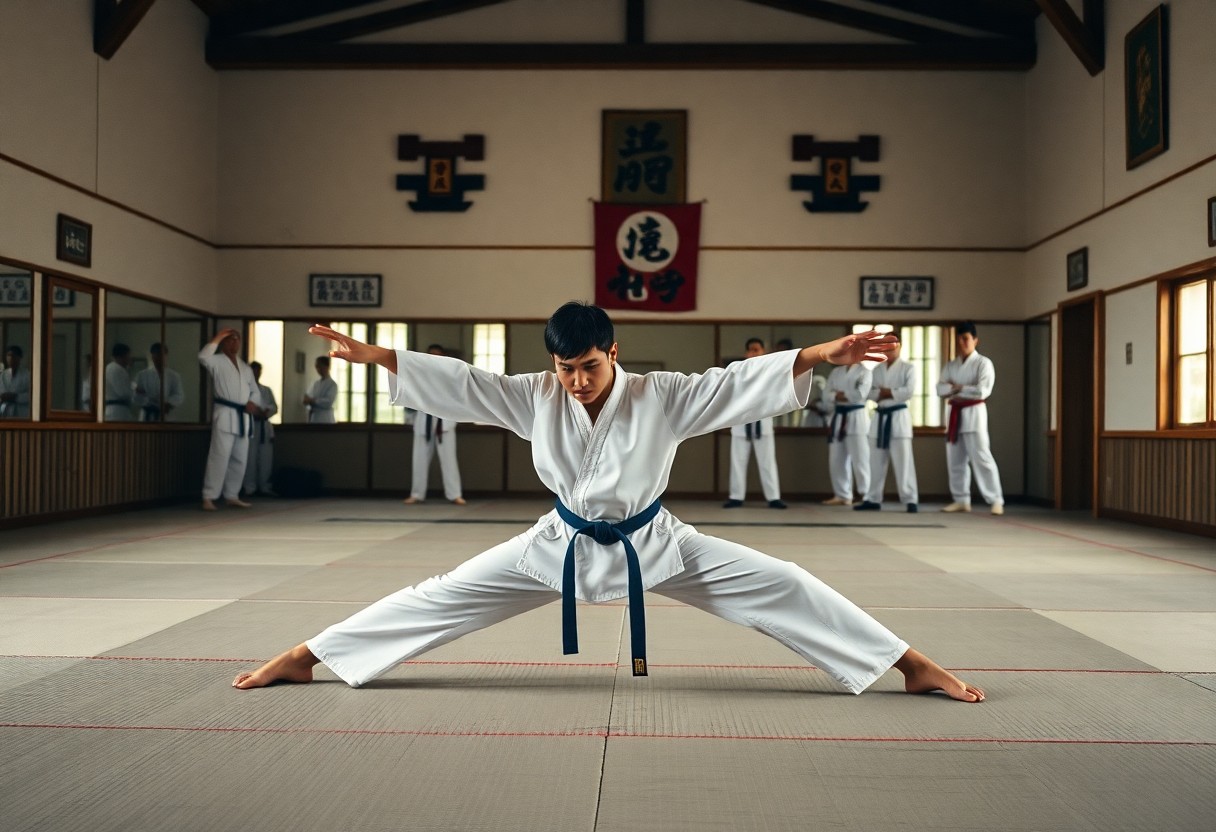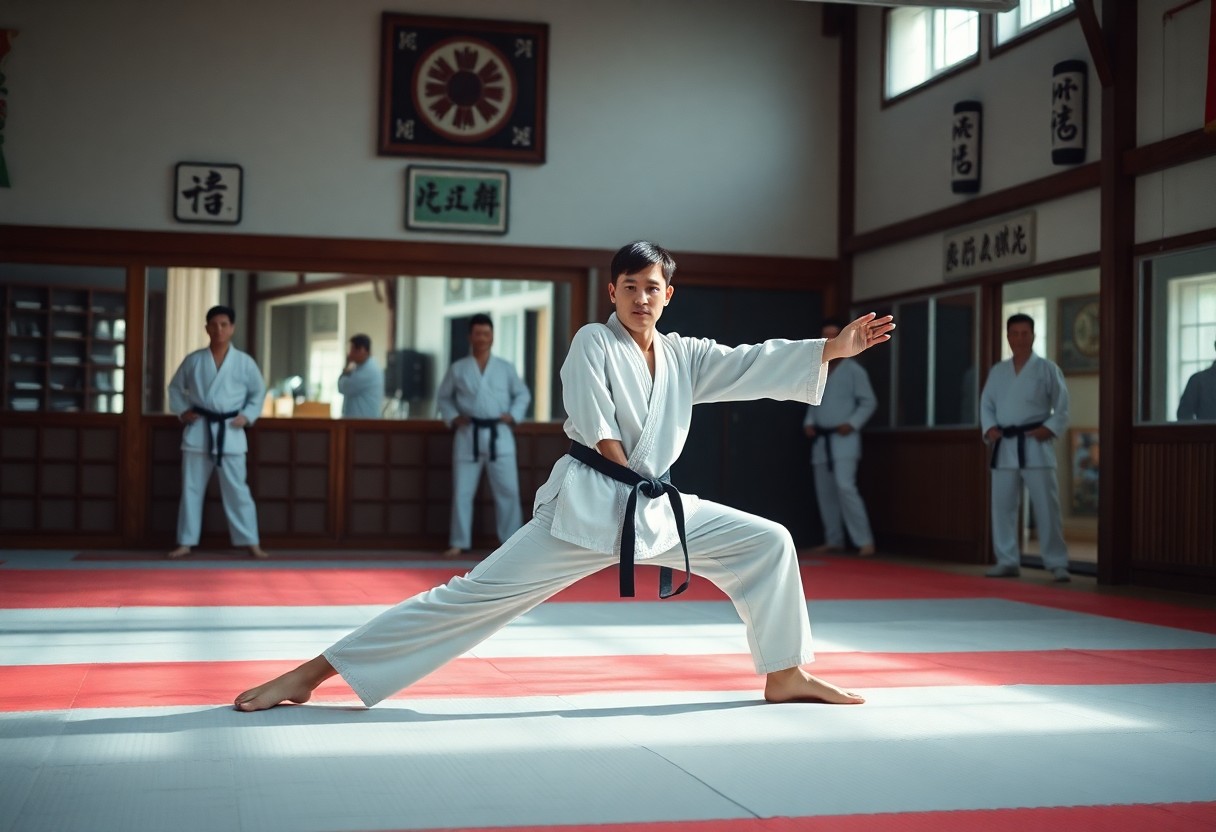You can enhance your Taekwondo practice by achieving impressive flexibility without risking injury. In this guide, I will share effective techniques and safety tips that have helped me and countless others develop a greater range of motion. Flexibility not only improves your kicks but also increases your overall performance in Taekwondo. By incorporating proper stretching routines and being mindful of your body, you can progress at a pace that suits your individual needs. Let’s probe the methods that will lead you to enhance your flexibility safely and effectively.
The Anatomy of Flexibility: Key Muscle Groups
Understanding flexibility is key for mastering martial arts like Taekwondo. The major muscle groups involved in flexibility include hamstrings, quadriceps, hip flexors, adductors, and the muscles of the lower back and core. Each of these muscles plays a significant role in executing high kicks, quick turns, and powerful stances. Focusing on these muscle groups allows for better performance and reduces the risk of injuries during training.
Identifying Target Muscles for Taekwondo
In Taekwondo, you’ll want to prioritize stretching the hamstrings, hip flexors, quadriceps, and groin muscles. Targeting these areas helps increase your kicking height and the range of motion in your movements. Regularly incorporating stretches and strengthening exercises for these specific muscles will improve your overall performance and enhance your technique.
The Role of Joint Mobility
Joint mobility is a vital aspect of flexibility, often overlooked in favor of traditional stretching. Joints like the hips, knees, and ankles can limit your range of motion if they aren’t properly maintained. Enhanced mobility allows for smoother transitions between kicks, stances, and movements, ultimately leading to a more fluid and effective Taekwondo practice.
Focusing on joint mobility means engaging in dynamic stretches, foam rolling, and specific joint exercises. For instance, incorporating hip circles and ankle rolls can improve blood flow and flexibility at the joints. This increased mobility not only supports flexibility but also plays a significant role in injury prevention. When your joints are limber, they work more efficiently, which helps you perform complex Taekwondo techniques with ease and confidence. Building a routine that emphasizes joint mobility can significantly enhance your performance and longevity in martial arts training.

Warm-Up Rituals: Setting the Stage for Progress
Your flexibility training can greatly benefit from a well-structured warm-up routine. Engaging in targeted warm-ups prepares your muscles and joints for the demands of Taekwondo practice, minimizing the risk of injuries. I recommend spending at least 10 to 15 minutes before each training session to effectively raise your body temperature, enhance blood flow, and increase joint mobility. This initial investment of time sets the foundation for a safe and productive stretching session.
Best Practices for Effective Warm-Ups
In my experience, a successful warm-up includes a blend of low-impact aerobic exercises, dynamic movements, and sport-specific activities. Start with 5 to 10 minutes of light cardio, such as jogging or skipping rope, to elevate your heart rate. Following this, incorporate movements that mimic the motions you will perform in Taekwondo, such as high knees and leg swings. This combination not only increases your body temperature but also primes your muscles for the specific flexibility challenges ahead.
Dynamic Vs. Static Stretching: What Works Best and When
Incorporating both dynamic and static stretching at the appropriate times can maximize your flexibility while minimizing injury risk. Dynamic stretching, characterized by active movements that mimic your workout, is ideal for warming up. Static stretching, which involves holding stretches for a set duration, is more beneficial after training when your muscles are warm. This distinction helps optimize your flexibility gains while keeping your body safe and prepared for action.
Dynamic stretching serves as a catalyst for flexibility in a Taekwondo context because it encourages muscle engagement and coordination without compromising performance. For instance, performing leg swings and arm circles dynamically stretches your muscles while ensuring that they are ready to execute powerful kicks and rapid movements. On the other hand, static stretches post-training, like hamstring holds or quadriceps stretches, not only help elongate the muscles but also contribute to recovery, reinforcing your flexibility gains over time. Striking the right balance between these two types of stretching can significantly enhance your overall performance in Taekwondo.
Stretching Strategies: Techniques to Boost Flexibility Safely
Embracing effective stretching strategies elevates your flexibility training and minimizes injury risks. Incorporating dynamic stretches before workouts stimulates the muscles and prepares them for intense movements. Post-workout, static stretches allow your muscles to relax and elongate. By sequencing these approaches, I ensure that my body remains agile while promoting safe advances in my flexibility journey. Engaging in consistent practice tailored to your skill level will create a sustainable path to improvement.
Essential Stretches for Taekwondo Practitioners
To enhance your flexibility specifically for Taekwondo, focus on key stretches like the butterfly stretch, hamstring stretch, and quadriceps stretch. Each of these targets crucial muscle groups heavily used in high kicks and powerful stances. I find incorporating these stretches into my routine not only helps in achieving greater flexibility but also aids in performing more complex techniques with greater ease and control. Make it a habit to hold each stretch for at least 30 seconds while breathing deeply for optimal results.
Incorporating Resistance Training for Greater Gains
Resistance training complements your flexibility regimen by strengthening the muscles while improving their elasticity. Engaging in bodyweight exercises, resistance bands, or weights not only builds muscle but enhances joint stability and overall performance. For instance, incorporating exercises like squats, lunges, and leg raises can help increase strength across key muscle groups involved in Taekwondo, allowing you to execute higher kicks and maintain balance more effectively.
Mixing resistance training with your flexibility work sparks faster progress while keeping injury at bay. Research has shown that strength training increases muscle elasticity, making it easier to reach new levels of flexibility. By integrating exercises like resistance band leg swings into my warm-ups and cooldowns, I reinforce both strength and flexibility simultaneously. This dual approach ensures I’m well-prepared for rigorous Taekwondo training, setting me up for success whether I’m sparring or breaking boards.
The Psychology of Flexibility Training: Staying Motivated
Maintaining motivation throughout your flexibility journey requires a blend of self-awareness and strategic goal-setting. Visualizing progress, celebrating small victories, and reminding yourself of your long-term objectives can create a positive feedback loop. Incorporate frequent self-assessments to gauge improvements, whether through increased range of motion or mastering a new stretch. Sharing your progress with training partners or online communities can also provide the social reinforcement needed to keep pushing forward.
Building a Consistent Flexibility Routine
A successful flexibility routine hinges on consistency. Dedicating a specific time each day to focus solely on your stretching practice can help establish a habit. Incorporate short sessions throughout your day, even taking just five minutes to stretch during breaks. Keep your routine varied to engage different muscle groups, and alternate between static and dynamic stretches. You’ll find that this consistent effort leads to tangible improvements over time.
Overcoming Mental Barriers: The Growth Mindset
Developing a growth mindset is vital for pushing past mental barriers in flexibility training. When you focus on learning and improving, setbacks become just part of the growth process, rather than roadblocks. Embracing challenges can transform your training experience into an exciting journey. Rather than seeing flexibility work as tedious, you can reframe it as a personal challenge, one where every small achievement builds your confidence and resilience.
By adopting a growth mindset, I’m not only focusing on my current abilities but also acknowledging that my flexibility can improve over time with dedicated effort. This perspective allows me to view uncomfortable stretches or days when I feel less limber as valuable lessons, keeping me engaged and motivated. I recommit to my goals when I see improvements as proof that I can overcome obstacles, reinforcing my motivation to continue developing my flexibility in Taekwondo and beyond.
Monitoring Progress: How to Measure Improvement
Recognizing improvement in flexibility requires objective measures. Keep a journal where you record your stretching routine, noting the duration and types of stretches performed each session. Use a simple assessment tool, like the sit-and-reach test or measuring how high you can kick, to provide tangible benchmarks. I also recommend taking photos weekly to visualize changes over time—this can be incredibly motivating as you see those incremental gains.
Tracking Flexibility Milestones
Establish specific milestones to track your flexibility journey effectively. For instance, aim to increase your range of motion in kicks or hold particular stretches for longer durations. Breaking your goals into monthly or bi-weekly milestones allows you to celebrate smaller victories, fostering a sense of accomplishment that keeps you committed to your training routine.
Adjusting Techniques as You Advance
As you observe progress, it’s imperative to adjust your techniques accordingly. Increasing your flexibility may require advancing to more challenging stretches or integrating different training methods. I found that incorporating dynamic stretching exercises during warm-ups enhances my flexibility gains, while also preventing plateauing. For instance, transitioning from static holds to active stretches can stimulate new muscle fibers, driving further improvement.
Periodic updates to your stretching routine can help maintain momentum. As you become more flexible, you might discover certain stretches that no longer challenge you—this is the ideal time to incorporate variations or introduce advanced techniques, like PNF (Proprioceptive Neuromuscular Facilitation) stretching. Additionally, listening to your body is key; if a stretch feels too easy, it’s time to increase intensity or explore new movements that target different muscle groups. This proactive approach not only keeps your routine engaging but also propels you toward achieving impressive flexibility safely and effectively.
Final Words
Taking this into account, I understand that achieving impressive Taekwondo flexibility is a journey that requires patience, consistency, and safety. By following a structured stretching routine, incorporating strength training, and listening to your body, you can enhance your flexibility effectively. Prioritizing proper technique and warm-ups will help prevent injuries, allowing you to reach your goals without setbacks. With dedication and the right approach, you’ll see progress that not only benefits your performance but also enriches your overall martial arts experience.
FAQ
Q: What are some effective warm-up exercises to improve flexibility for Taekwondo?
A: Before starting any flexibility training, it’s important to warm up your body to prevent injuries. Dynamic stretches like leg swings, arm circles, and torso twists can effectively increase blood flow to the muscles. Additionally, incorporating movements such as high knees and butt kicks can help loosen the hips and legs. Taking at least 10-15 minutes for this warm-up phase prepares your body for more intense stretching exercises.
Q: How often should I practice flexibility exercises for Taekwondo?
A: To see consistent improvements, it’s recommended to practice flexibility exercises at least 3-4 times a week. Sessions can range from 20 to 30 minutes, focusing on different muscle groups each time. Ensure that you are not only stretching during your Taekwondo practice but also dedicating standalone sessions to flexibility. This regularity helps maintain and gradually improve your flexibility over time.
Q: What techniques should I use to stretch safely while training for Taekwondo?
A: Safe stretching techniques include static stretching, where you hold a position for 15-30 seconds, and dynamic stretches that involve moving parts of your body through a full range of motion. Avoid bouncing during stretches, as this can lead to injuries. Instead, focus on controlled movements and using proper form. Always listen to your body; if you feel sharp pain, ease back and consult a coach for alternative methods.

